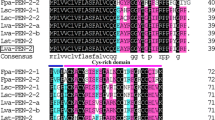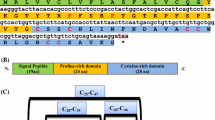Abstract
The present study reports for the first time the involvement of an antimicrobial peptide in the defense reactions of a shrimp infected by a pathogenic Vibrio, Vibrio penaeicida. New members of the penaeidin family were characterized in the shrimp Litopenaeus stylirostris by RT-PCR and RACE-PCR from hemocyte total RNAs, and by mass spectrometry detection and immunolocalization of mature peptides in shrimp hemocytes. In infected shrimps, bacteria and penaeidin distribution colocalized in the gills and the lymphoid organ that represented the main infected sites. Moreover, the shrimp immune response to infection involved massive hemocyte recruitment to infection sites where released penaeidin may participate in the isolation and elimination of the bacteria, We show that the ability of the shrimps to circumvent shrimp infections is closely related to a recovery phase based on the hematopoietic process.
Similar content being viewed by others
Author information
Authors and Affiliations
Corresponding author
Additional information
Received 25 November 2003; received after revision 8 January 2004; accepted 21 January 2004
Rights and permissions
About this article
Cite this article
Muňoz, M., Vandenbulcke, F., Garnier, J. et al. Involvement of penaeidins in defense reactions of the shrimp Litopenaeus stylirostris to a pathogenic vibrio. CMLS, Cell. Mol. Life Sci. 61, 961–972 (2004). https://doi.org/10.1007/s00018-003-3441-9
Issue Date:
DOI: https://doi.org/10.1007/s00018-003-3441-9




